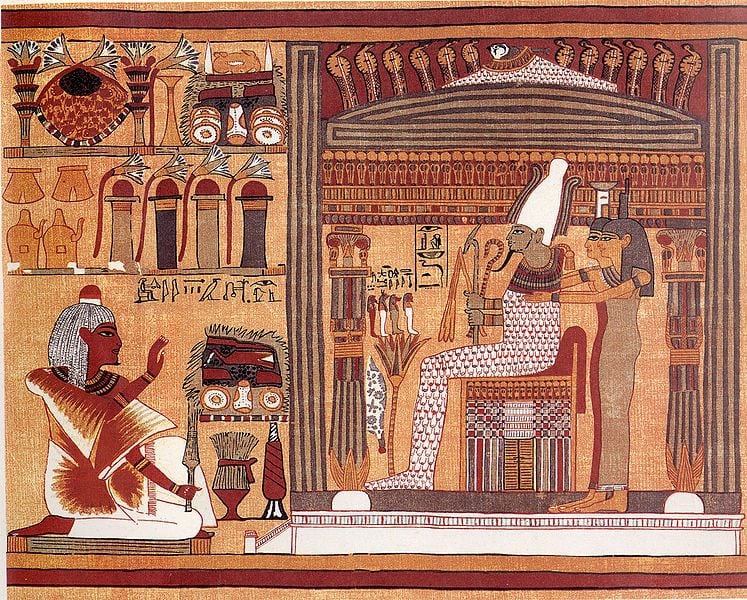
(Wikimedia Commons public domain image; a reproduction of the “Papyrus of Ani” hangs on one of the interior walls of my home)
From time to time, whether on the internet or in pamphlet form or even in a triumphant personal email sent directly to me, I run across dismissals of the story of Jesus as purely fictional — on the grounds that all of the important facets of his life were merely (and obviously) borrowed from the legends of other dying-and-resurrecting gods, etc. I wrote a column back in mid-2012 in which I briefly responded to this fairly common atheist approach: “‘Parallels’ of prophets not parallel.” I think that I’ll respond to it briefly once again:
In one of his bestselling books, the British evolutionary biologist Richard Dawkins declares that “all the essential features of the Jesus Legend . . . are borrowed — every last one of them — from other religions already in existence in the Mediterranean and Near East region.” (Richard Dawkins, The God Delusion [New York: Houghton Mifflin, 2008], 119-120)
But is this true? Almost certainly not. There is scarcely a modern expert in any relevant field — I can think, at the moment, of none — who would agree with Professor Dawkins, a passionate writer but a man who has shown virtually no interest in or acquaintance with the relevant historical scholarship.
I will cite a couple of passages from two scholars who have researched the topic and written on it. They focus specifically on the fascinating Egyptian myth of Isis and Osiris, which can indeed seem (at first glance) to be similar to the story of the death and resurrection of Jesus of Nazareth.
The first of these scholars is the late American philosopher Ronald H. Nash, author of (among other things) the 1992 book The Gospel and the Greeks:
The basic myth of the Isis cult concerned Osiris, her husband during the earlier Egyptian and nonmystery stage of the religion. According to the most common version of the myth, Osiris was murdered by his brother who then sank the coffin containing Osiris’s body into the Nile River. Isis discovered the body and returned it to Egypt. But her brother-in-law once again gained access to the body, this time dismembering it into fourteen pieces which he scattered widely. Following a long search, Isis recovered each part of the body. It is at this point that the language used to describe what followed is crucial. Sometimes those telling the story are satisfied to say that Osiris came back to life, even though such language claims far more than the myth allows. Some writers go even further and refer to the alleged “resurrection” of Osiris. One liberal scholar illustrates how biased some writers are when they describe the pagan myth in Christian language: ‘The dead body of Osiris floated in the Nile and returned to life, this being accomplished by a baptism in the waters of the Nile” (Joseph Klausner, From Jesus to Paul [New York: Macmillan, 1943], 104.). This biased and sloppy use of language suggests three misleading analogies between Osiris and Christ: (1) a savior god dies and (2) experiences a resurrection accompanied by (3) water baptism. But the alleged similarities, as well as the language used to describe them, turn out to be fabrications of the modern scholar and are not part of the original myth. Comparisons between the resurrection of Jesus and the resuscitation of Osiris are greatly exaggerated. Not every version of the myth has Osiris returning to life; in some he simply becomes king of the underworld. Equally far-fetched are attempts to find an analogue of Christian baptism in the Osiris myth. The fate of Osiris’s coffin in the Nile is as relevant to baptism as the sinking of Atlantis. (From Ronald H. Nash, “Was The New Testament Influenced by Pagan Religions?” https://www.equip.org/articles/was-the-new-testament-influenced-by-pagan-religions/.)
The second authority whose words I will cite here is the eminent British New Testament scholar N. T. Wright, who is currently a senior research fellow at Wycliffe Hall in the University of Oxford:
At the heart of the cults was the ritual re-enactment of the death and rebirth of the god, coupled with sundry fertility rites. The productivity of the soil, and of the tribe or nation, was at stake; by getting in touch with the mysterious forces that underlay the natural world, by sympathetic and symbolic re-enactment of them, one might hope to guarantee both crops and offspring. The myth which accompanied these rituals was indeed the story of resurrection, of new life the other side of death. . . . Did any worshiper in these cults, from Egypt to Norway, at any time in antiquity, think that actual human beings, having died, actually came back to life? Of course not. These multifarious and sophisticated cults enacted the god’s death as a metaphor, whose concrete referent was the cycle of seed-time and harvest, of human reproduction and fertility. Sometimes, as in Egypt, the myths and rituals included funerary practices: the aspiration of the death was to become united with Osiris. But the new life they might thereby experience was not a return to life in the present world. Nobody expected the actual mummies to get up, walk about and resume normal living; nobody in that world would have wanted such a thing, either. (N. T. Wright, The Resurrection of the Son of God [Minneapolis: Fortress Press, 2003], 80-81 [emphasis in the original])
I would add something else, too, that I consider significant. There seems to me a world of difference between stories like those of Osiris and Tammuz, which are depicted as having occurred vaguely “long, long ago,” and the story of Jesus, which began, according to the gospel of Luke 2:1-2, when “there went out a decree from Caesar Augustus that all the world should be taxed (and this taxing was first made when Cyrenius was governor of Syria).”
The version of the Nicene Creed that was adopted at the First Council of Constantinople in AD 381, summarizing the accounts given in the New Testament gospels, incorporates a specific historical reference into the very creed itself:
σταυρωθέντα τε ὑπὲρ ἡμῶν ἐπὶ Ποντίου Πιλάτου, καὶ παθόντα καὶ ταφέντα, καὶ ἀναστάντα τῇ τρίτῃ ἡμέρᾳ
he was crucified for us under Pontius Pilate, and suffered, and was buried, and the third day he rose again
No comparable specificity is available for the ancient mystery cults.
Consider, too, the words of the evangelist Luke, cited here (for the sake of clarity) from Luke 1 in the Common English Bible:
1 Many people have already applied themselves to the task of compiling an account of the events that have been fulfilled among us. 2 They used what the original eyewitnesses and servants of the word handed down to us. 3 Now, after having investigated everything carefully from the beginning, I have also decided to write a carefully ordered account for you, most honorable Theophilus. 4 I want you to have confidence in the soundness of the instruction you have received.
No such account is available with regard to Osiris.
Posted from Park City, Utah

















